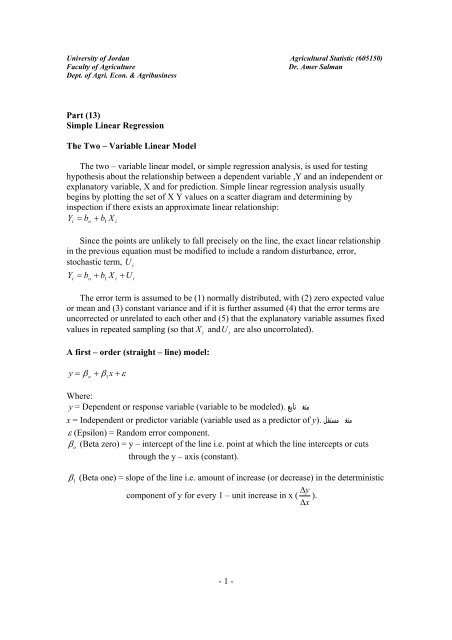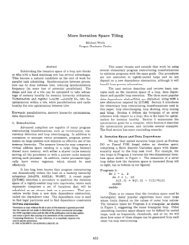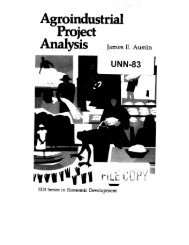Part 13- Simple linear regression - The University of Jordan
Part 13- Simple linear regression - The University of Jordan
Part 13- Simple linear regression - The University of Jordan
You also want an ePaper? Increase the reach of your titles
YUMPU automatically turns print PDFs into web optimized ePapers that Google loves.
<strong>University</strong> <strong>of</strong> <strong>Jordan</strong> Agricultural Statistic (605150)Faculty <strong>of</strong> AgricultureDr. Amer SalmanDept. <strong>of</strong> Agri. Econ. & Agribusiness<strong>Part</strong> (<strong>13</strong>)<strong>Simple</strong> Linear Regression<strong>The</strong> Two – Variable Linear Model<strong>The</strong> two – variable <strong>linear</strong> model, or simple <strong>regression</strong> analysis, is used for testinghypothesis about the relationship between a dependent variable ,Y and an independent orexplanatory variable, X and for prediction. <strong>Simple</strong> <strong>linear</strong> <strong>regression</strong> analysis usuallybegins by plotting the set <strong>of</strong> X Y values on a scatter diagram and determining byinspection if there exists an approximate <strong>linear</strong> relationship:= b + b XYio 1iSince the points are unlikely to fall precisely on the line, the exact <strong>linear</strong> relationshipin the previous equation must be modified to include a random disturbance, error,stochastic term, UY X + Ui= bo+ b1iii<strong>The</strong> error term is assumed to be (1) normally distributed, with (2) zero expected valueor mean and (3) constant variance and if it is further assumed (4) that the error terms areuncorrected or unrelated to each other and (5) that the explanatory variable assumes fixedvalues in repeated sampling (so that X andU are also uncorrolated).A first – order (straight – line) model:= β + β x + εyo 1iWhere:متغير تابع modeled). y = Dependent or response variable (variable to beمتغير مستقل y). x = Independent or predictor variable (variable used as a predictor <strong>of</strong>ε (Epsilon) = Random error component.βo(Beta zero) = y – intercept <strong>of</strong> the line i.e. point at which the line intercepts or cutsthrough the y – axis (constant).β1(Beta one) = slope <strong>of</strong> the line i.e. amount <strong>of</strong> increase (or decrease) in the deterministic∆ ycomponent <strong>of</strong> y for every 1 – unit increase in x ( ).∆xi- 1 -
<strong>University</strong> <strong>of</strong> <strong>Jordan</strong> Agricultural Statistic (605150)Faculty <strong>of</strong> AgricultureDr. Amer SalmanDept. <strong>of</strong> Agri. Econ. & AgribusinessY32β1= slope1β = y - Intercepto0 X1 2 3 4 5Example (<strong>13</strong> – 1):Y = tomato productionX = fertilizer quantityY = 10 + 2xتمثل الإنتاج في حالة عدم إضافة أي كمية من السماد :10نسبة الزيادة في الإنتاج عند إضافة وحدة واحدة من السماد (إنتاجية الوحدة الواحدة من السماد ( :2Yβ1= slope =2β = 10o0 X1 2 3 4 5ˆ = ˆ β + ˆ β xyo 1قيمة الإنتاج المقدرة (المتوقعة ( = ŷβˆ o ,1ˆβ = estimated population parametersˆ = β + β xyo 1- 2 -
<strong>University</strong> <strong>of</strong> <strong>Jordan</strong> Agricultural Statistic (605150)Faculty <strong>of</strong> AgricultureDr. Amer SalmanDept. <strong>of</strong> Agri. Econ. & Agribusinessβ∑∑x y1=2xx = X − Xy = Y − YFitting the model: the Method <strong>of</strong> Least SquaresSuppose that we have the following equation:y ˆ = −1+xx y ŷ ( y − yˆ)2( y − yˆ)(SSE)1 1 0 (1 – 0) = 1 12 1 1 (1 – 1) = 0 03 2 2 (2 – 2) = 0 04 2 3 (2 – 3) = -1 15 4 4 (4 – 4) = 0 0Sum <strong>of</strong> errors = 0 Sum <strong>of</strong> Squared errors = 2Y3y ˆ = −1+x210-11 2 3 4 5XIt can be shown that there is one (and only one) line for which the SSE is a minimum.This line is called the least square line, the <strong>regression</strong> line, the least squares equation orthe fitted line.- 3 -
Ça bouge en villeJusqu’au 23 avril, durantles travaux pour la constructiond’un bassin d’orage, il n’est paspossible de stationnerdans la rue de la Roselière et lavitesse est limitée à 30 km/h.Rue de Mulhouse (tronçon ruede Séville - rue de l’Aéroport),du 14 mars au 31 mai, la vitessesera limitée à 30 km/h etle stationnement sera interditpour cause de réaménagementde trottoirs.Le renouvellement du réseaugaz continue sur l’avenue Généralde Gaulle et rue de l’Horticulture.Avenue Général de Gaulle,la vitesse est limitée à 30 km/h.Rue de l’horticulture,la circulation est interdite, saufpour les riverains. Il n’est paspossible de se stationner.Rue de l’Église, les travauxconcernent le réseau électriquebasse tension et la voirie. Lestationnement et la circulationsont interdits pendant les travaux.Les rues du Jura et des Alpes sont de nouveau praticables.Rues du Jura et des AlpesToutes neuves !Démarrés en novembre, les travaux devoirie des rues du Jura et des Alpessont sur le point d’être finis. Ce chantierentre dans le programme de voirie2010. 220 000 € TTC ont été nécessairepour refaire entièrement les chaussées.“Elles en avaient besoin et laconstruction du commissariat de policea été l’occasion de lancer le chantier”,affirme Bernard Schmitter, adjointà l’urbanisme et à la voirie de la villede Saint-Louis. Les chaussées, surenviron 400 mètres linéaires, ont étédécaissées sur 50 cm de pr<strong>of</strong>ondeur.Un film géotextile a été posé, puis unecouche de gravier et une couche degraves fines. La touche finale a été letapis d’enrobés, posé tout récemment.L’éclairage public et les trottoirs ontégalement été refaits.Opération nids de pouleLa légère accalmie climatique de mijanviera permis aux services de laVille, avec l’appui d’une entreprise privée,de traiter un grand nombre detrous en formation sur près de 30 rues.En effet, le gel et le sel avaient fortementdégradé les chaussées. À l’heureactuelle, tous les nids de poules ontété rebouchés. Les riverains sont invitésà signaler en mairie (services techniques)les nouveaux nids de poulesdès formation de ceux-ci.Ici, les nids de poulesde la rue Baerenfelsont été rebouchés.5 À l’action
<strong>University</strong> <strong>of</strong> <strong>Jordan</strong> Agricultural Statistic (605150)Faculty <strong>of</strong> AgricultureDr. Amer SalmanDept. <strong>of</strong> Agri. Econ. & AgribusinessTable (<strong>13</strong> – 2):n Y (corn)iXi(fertilizer) ( Y i− Y )yi( X i− X )xi( x y ) 2i i x1 40 6 -17 -12 204 1442 44 10 -<strong>13</strong> -8 104 643 46 12 -11 -6 66 364 48 14 -9 -4 36 165 52 16 -5 -2 10 46 58 18 1 0 0 07 60 22 3 4 12 168 68 24 11 6 66 369 74 26 17 8 <strong>13</strong>6 6410 80 32 23 14 322 196n = 10 Y =570 X =180 y =0 x =0 ∑ i i ∑ x 2 i=576∑ iY = 57∑ iX = 18∑ i∑ iiTable (<strong>13</strong> – 2) shows the calculation to estimate the <strong>regression</strong> equation for the corn –fertilizer problem in table (1) using the equation:ˆxiyi956bi= = 1.66 (<strong>The</strong> slope <strong>of</strong> the estimate <strong>regression</strong> line)2x 576=∑∑ibˆˆo= Y − b X ≅ 57 − (1.66)(18) = 57 − 29.88 27.12 (<strong>The</strong> Y – Intercept)1≅Yˆ = 27.12 + 1. 66 (<strong>The</strong> estimated <strong>regression</strong> equation)iX iThus when X i= 0, Yˆ i = 27.12, X = Xi=18, Yˆ i = 27.12 + 1.66 (18) =57 = Y as a result, the<strong>regression</strong> line passes through point X Y .- 6 -
<strong>University</strong> <strong>of</strong> <strong>Jordan</strong> Agricultural Statistic (605150)Faculty <strong>of</strong> AgricultureDr. Amer SalmanDept. <strong>of</strong> Agri. Econ. & AgribusinessYŶ iβ1= 1.66β = 27.12oXExample (<strong>13</strong> – 3):X Y ( Y i− Y )∑ iiiyi( X i− X )xi( x y ) 2i i x1 1 -1 -2 2 42 1 -1 -1 1 <strong>13</strong> 2 0 0 0 04 2 0 1 0 15 4 2 2 4 4X =15 Y = 10 y =0 x =0 ∑ xiyi=7 ∑ x 2 i=10X = 3∑ iY = 2∑ i∑ iib ˆˆib o=∑∑x7=10i i=2ixy= Y − bˆX0.7= 2 − (0.7)(3) =1−0.1Y ˆ = −0.1+ 0. 7iX i- 7 -
<strong>University</strong> <strong>of</strong> <strong>Jordan</strong> Agricultural Statistic (605150)Faculty <strong>of</strong> AgricultureDr. Amer SalmanDept. <strong>of</strong> Agri. Econ. & AgribusinessY0.7-0.1XExample (<strong>13</strong> – 4):Yˆ= 10 − 5Xβ = 10oYβ1= -5XExample (<strong>13</strong> – 5):Yˆ= −10− 5X- 8 -
<strong>University</strong> <strong>of</strong> <strong>Jordan</strong> Agricultural Statistic (605150)Faculty <strong>of</strong> AgricultureDr. Amer SalmanDept. <strong>of</strong> Agri. Econ. & AgribusinessYXβ = -10oβ1= -5Test <strong>of</strong> Significance <strong>of</strong> Parameter EstimatesIn order to test for statistical significance <strong>of</strong> the parameter estimates <strong>of</strong> the <strong>regression</strong>the variance <strong>of</strong>bˆ o and ˆb 1is required.∑∑2var ˆx2 ibo= σu 2n xˆ 2 1varb = σu 2x∑1LiiL(1)(2)s2Sinceσ2 uis unknown, the residual variance s 2 2is used as an (unbiased) estimate <strong>of</strong>σ u:22ˆ∑ei= σu= L(3).(Where k = number <strong>of</strong> parameter estimates).n − kUnbiased estimates <strong>of</strong> the variance <strong>of</strong>bˆ o and ˆb 1are then given by:∑2222∑∑ ∑2 ˆ = eixi×⇒ ˆ ei(4) =−−× xiS boL S b2on k n xn k n x2∑e i= ( Y − Yˆ)n = number <strong>of</strong> observations.k = number <strong>of</strong> parameters.i∑i- 9 -
<strong>University</strong> <strong>of</strong> <strong>Jordan</strong> Agricultural Statistic (605150)Faculty <strong>of</strong> AgricultureDr. Amer SalmanDept. <strong>of</strong> Agri. Econ. & Agribusiness∑22ei1∑×⇒ ˆei(5) S b =− ∑−×21n k xin k ∑2 bˆ1= 12xiS LSo that S b ˆ o and S ˆb 1are the standard errors <strong>of</strong> the estimates. SinceU iis normallydistributed, Yiand therefore bˆ o and ˆb 1are also normally distributed, so that we can use thet distribution with n – k degrees <strong>of</strong> freedom, to test hypotheses about and constantconfidence intervals forbˆ o and ˆb 1.tocalbo− bo= ˆSbo,t1calbˆ1− b=Sb11df = n – k (n – 2 always).α = 5 %; one tailed (α), two tailed (α/2).Example (<strong>13</strong> – 6):<strong>The</strong> following table shows the calculations required to test the statistical significance<strong>of</strong>bˆ o and ˆb 1. <strong>The</strong> value <strong>of</strong> Yˆ iin the table are obtained by subtracting the values <strong>of</strong> Xiintothe estimated <strong>regression</strong> equation Yˆ 2i= 27.12 + 1. 66Xi(<strong>The</strong> values <strong>of</strong> yiare obtained bysquaring yi( Y i− Y ).Table (<strong>13</strong> – 3):year Y (corn)iXi(fertilizer)Yˆ i( Y − Yˆ)e= i2ei2Xi2xi2yi2( Y i− Y )1 40 6 37.08 2.92 8.5264 36 144 2892 44 10 43.72 0.28 0.0784 100 64 1693 46 12 47.04 -1.04 1.0816 144 36 1214 48 14 50.36 -2.36 5.5696 196 16 815 52 16 53.68 -1.68 2.8224 256 4 256 58 18 57.00 1.00 1.0000 324 0 17 60 22 63.64 -3.64 <strong>13</strong>.2496 384 16 98 68 24 66.96 1.04 1.0816 576 36 1219 74 26 70.28 3.72 <strong>13</strong>.8384 676 64 28910 80 32 80.24 -0.24 0.0576 1,024 196 529n=10∑Y i=570Y =57∑ iX =180X =18∑ ie =0∑e2 i=47.3056∑ X2i=3,816∑ x2 i=576∑ y2 i=1,634- 10 -
<strong>University</strong> <strong>of</strong> <strong>Jordan</strong> Agricultural Statistic (605150)Faculty <strong>of</strong> AgricultureDr. Amer SalmanDept. <strong>of</strong> Agri. Econ. & AgribusinessS2bˆS bˆoo∑2ei= ×n − k n∑∑x= 3.92 = 1.982ix2i=47.3056×10 − 2381610(576)= 3.922S bˆ=S bˆ11∑2ei×n − k∑1x= 0.01 ≅ 0.12i47.3056=≅ 0.01(10 − 2)(576)bˆo− bo27.12 − 0bˆ1− b11.66 − 0<strong>The</strong>refore, tocal= = ≅ <strong>13</strong>. 7 and t1 = = = 16. 6Sbˆ1.98calSb 0.1Since bothtocaltandot 1 calexceed t tabsignificance we [ t t ]= 2.306 with df = n – k = 8 at 5 % level <strong>of</strong>o,1>cal cal tabconclude that bothb 0.025oand b 1are significant at the 5 %level <strong>of</strong> significance (two tailed).1RejectionRegionAcceptance RegionRejection Regiont =2.306tab α /2t =2.306 <strong>13</strong>.7 16.6tab α /2- 11 -
<strong>University</strong> <strong>of</strong> <strong>Jordan</strong> Agricultural Statistic (605150)Faculty <strong>of</strong> AgricultureDr. Amer SalmanDept. <strong>of</strong> Agri. Econ. & AgribusinessA Test <strong>of</strong> Model UsefulnessTable (<strong>13</strong> – 4):One tailed testH : β = 0 1Hoa: β1 < 0, or Ha: β1>Test statistic = t0ˆ β − βS ˆ β1ˆ β − βS ˆ βoTwo tailed testH : β = 0 1Hoo: β1 ≠ 01 1o o1= , to=Test statistic = t1Rejection region t < −tα, or t > tWheret αis based on (n – 2) dfαˆ β1− β1= , tS ˆ β1oˆ βo− βo=S ˆ βRejection region t < −tα/ 2, or t > tα/ 2Wheret αis based on (n – 2) dfFor example (<strong>13</strong> – 3), we will choose α = 0.05 and, since n = 5, df = (n – 2) = 3, then therejection region for the two tailed test is:t < −t= − .182, or t > t 3.1820 .02530. 025=os2=SSEn − k=SSEn − 2Where:2SSE ( yi− yˆ ) = SSyy− ˆ β1SS∑=xy∑( y − y)2∑( ∑ yi)2SSyy=i= yi−n2 1.10s = = 0.367 ⇒ s = 0.367 = 0.6<strong>13</strong>We estimated previously 1ˆβ = 0.7, s = 0.61 and SSThus:βt =s / SSxx0.7 0.7= =0.61/ 10 0.19ˆ1 =23.7xx( x )222 ∑ i (15)= ∑ xi− = 55 − = 10n5- 12 -
<strong>University</strong> <strong>of</strong> <strong>Jordan</strong> Agricultural Statistic (605150)Faculty <strong>of</strong> AgricultureDr. Amer SalmanDept. <strong>of</strong> Agri. Econ. & AgribusinessRejectionRegionRejectionRegionttab =-3.182ttab =3.182 tcal= 3.7ttab < tcal ; 3.182 < 3.7Since the calculated t value falls in the upper – tail rejection region we reject the nullhypothesis and conclude that the slope <strong>of</strong>1ˆβ is not 0 and it is significant at 5 % level <strong>of</strong>significance.Another way to make inference about the slope <strong>of</strong>1ˆβ is not estimate it using aconfidence interval as follows:ˆ ˆsβ1± tα / 2Sβ1When S βˆ = , and tα / 2is based on (n – k) df.SS xxˆ ˆ⎛ 0.61⎞β1 ± tα / 2Sβ1= 0.7 ± 3.182⎜⎟ = 0.7 ± 0.61⎝ 10 ⎠Thus we estimate with 95 % confidence that the interval from 0.09 to 1.31 includes theslope parameter β1. We would expect a narrower interval if the sample size wereincreased.Test <strong>of</strong> Goodness <strong>of</strong> Fit and Correlation<strong>The</strong> closer the observations fall to the <strong>regression</strong> line (i.e. the smaller the residuals),the greater is the variation in Y “explained” by the estimated <strong>regression</strong> equation. <strong>The</strong>total variation in Y is equal to the explained plus the residual variation:- <strong>13</strong> -
<strong>University</strong> <strong>of</strong> <strong>Jordan</strong> Agricultural Statistic (605150)Faculty <strong>of</strong> AgricultureDr. Amer SalmanDept. <strong>of</strong> Agri. Econ. & Agribusiness22222 2( Y − Y ) = ( Yˆ− Y ) + ( Y − Yˆ) ,[ y = yˆe ]∑ i ∑ i i ∑ i i ∑ i ∑ i+ ∑Total variation = Explained variation + Residual variationIn Y (or total in Y (or <strong>regression</strong> in Y (or errorSum <strong>of</strong> squares) sum <strong>of</strong> squares) sum <strong>of</strong> squares)TSS = RSS + ESSDividing both sides by TSS:RSS ESS1 = +TSS TSS2<strong>The</strong> coefficient <strong>of</strong> determination or R is then defined as the proportion <strong>of</strong> the totalvariation in Y explained by the <strong>regression</strong> <strong>of</strong> Y on X.iR2RSS= = 1−TSSESSTSS2R Can be calculated by:R2∑∑∑∑22= yˆiei= 1−2y y2ii∑∑Where: y ˆ = ( − ) 2iYiYi22∑ei= ∑ ( Y i− Yˆi)22∑ yi= ∑ ( Yi− Y )2 ˆ2R Ranges in value from 0 (zero when the estimated <strong>regression</strong> equation explains non<strong>of</strong> the variation in Y) to 1 (when all points lie on the <strong>regression</strong> line).<strong>The</strong> Correlation Coefficient:r<strong>The</strong> correlation coefficient is given by:∑ x2 iyi∑== ˆxiyiRb12 2x y yi=2∑i∑i∑- 14 -
<strong>University</strong> <strong>of</strong> <strong>Jordan</strong> Agricultural Statistic (605150)Faculty <strong>of</strong> AgricultureDr. Amer SalmanDept. <strong>of</strong> Agri. Econ. & Agribusinessr ranges in value from -1 (for perfect negative <strong>linear</strong> correlation) to +1 (for perfectpositive <strong>linear</strong> correlation) and dose not imply causality or dependence.Example (<strong>13</strong> – 7):<strong>The</strong> coefficient <strong>of</strong> determination for the corn – fertilizer example can be found from:R2=∑∑e2i1−2yi47.31≅ 1−= 1−0.0290 = 0.9710 ≅ 97.10%1634Thus the <strong>regression</strong> equation about 97 % <strong>of</strong> the total variation in corn output, theremaining 3 % is attributed to factors included in error term. <strong>The</strong>n:2r = R = 0.971 = 0.9854 Or 98.54 % and is positive because ˆb 1is positive.Example (<strong>13</strong> – 8):nXiYixiX i− XyiY i− Yxiy i2xiŶi2ei( Y ) 2i− Yˆiy22Xii1 1 1 -2 -1 2 4 0.6 0.16 1 12 2 1 -1 -1 1 1 1.3 0.09 4 <strong>13</strong> 3 2 0 0 0 0 2 0 9 04 4 2 1 0 0 1 2.7 0.49 16 05 5 4 2 2 4 4 3.4 0.36 25 4n=5 ∑X =15iX =3∑ iY =2Y =10∑ ix =0ˆxiyi7β1= = 0.7 ,2x 10iˆ β ˆo= Y − β X = 2 − (0.7)(3) =Y ˆ = −0.1+ 0. 7x=∑∑2S ˆ β =S ˆ β =oo∑1−2ei×n − k n∑∑x2i2xi0.4033 = 0.6351.1= ×5 − 20.1∑ i555(10)y =0∑ =7 ∑ 2 ix i y i60.5= = 0.4033150x =10∑ 2 ie =1.1∑ 2 iX =55( Y Y ) 2i−∑ 2 iy =6- 15 -
<strong>University</strong> <strong>of</strong> <strong>Jordan</strong> Agricultural Statistic (605150)Faculty <strong>of</strong> AgricultureDr. Amer SalmanDept. <strong>of</strong> Agri. Econ. & Agribusiness2S ˆ β =S bˆ11=∑2ei×n − k∑1x2i0.03667 = 0.1911.1= ×5 − 2110= 0.03667obˆo− b=Sboo=− 0.1−0= −0.1570.635tcal66bˆ1− b= Sb0.7 − 0=0.19111=<strong>13</strong>.tcal025tα / 2 0.(Two tailed) at 5 % significance level, df (n – k) = (5 – 2) = 3ttab=3.182- t tabttabRejectHoAcceptHoRejectHo-3.182-0.157 0 3.182 3.66to calt 1 calt1; reject Ho , accept Ha ; t 1is significantto; accept Ho , reject Ha ; t ois insignificanttcal> t tabR2=r = R∑∑e2i1−2yi2=1.1≅ 1−= 0.816 ≅ 81.67%60.8167 = 0.9037- 16 -
<strong>University</strong> <strong>of</strong> <strong>Jordan</strong> Agricultural Statistic (605150)Faculty <strong>of</strong> AgricultureDr. Amer SalmanDept. <strong>of</strong> Agri. Econ. & Agribusinessxمعناه أن التغير الحاصل في yنتيجة التغير الحاصل فييمكن تفسيره بنسبة صحة مقدارها %81.67 والباقي يعزى إلى عوامل2Rأخرى.Example (<strong>13</strong> – 9):<strong>The</strong> following table shows the relation between N (x) and Potato production (y). Find the<strong>regression</strong> equation and the coefficient <strong>of</strong> determination R 2 and sketch the curveaccording to your results.XiYixiX i− XyiY i− Yx y 2i i xiYˆi2ei( Y − Y ) 2iˆi2Xi2yi( Y Y) 2i−1 1 -2.5 -1.75 4.375 6.25 1.115 0.03<strong>13</strong> 1 3.0633 2 -0.5 -0.75 0.375 0.25 2.423 0.1759 9 0.5634 4 0.5 1.25 0.625 0.25 3.077 0.852 16 1.5636 4 2.5 1.25 3.125 6.25 4.385 0.1479 36 1.563X =3.5 Y =2.75 8.5 <strong>13</strong> 1.1923 6.75Yˆ= βo+ β1x ; β1= 0.654, βo= 0.461Yˆ = 0.461+0. 654x (Regression equation)Yβ 1β oX2∑ e < ∑R22iy i=∑∑e2i1−2yi1.1923≅ 1−= 0.8236.75- 17 -













![Problem 1: Loop Unrolling [18 points] In this problem, we will use the ...](https://img.yumpu.com/36629594/1/184x260/problem-1-loop-unrolling-18-points-in-this-problem-we-will-use-the-.jpg?quality=85)


